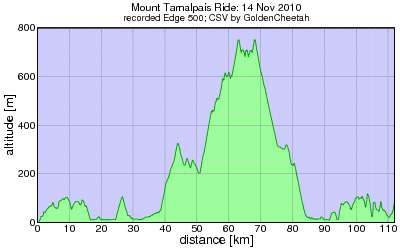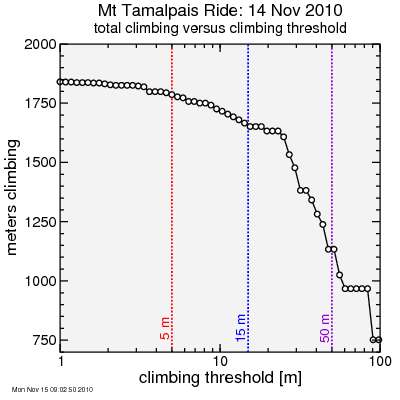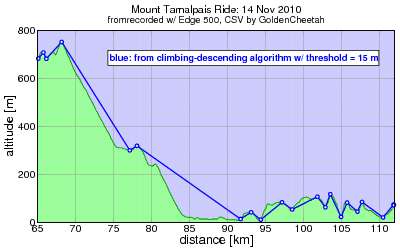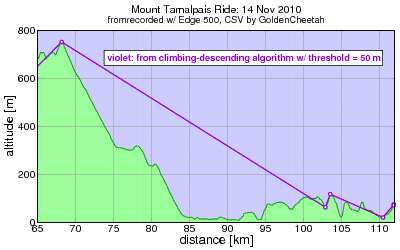testing the total climbing algorithm
On Sunday I did the following ride. I'd like to say this sort of thing is typical but sadly it was the longest ride I'd done in at least 5 weeks. New job and a tendency toward Sunday rain around here has kept me from getting in any long ones lately:

I imported my Edge 500 data into GoldenCheetah, exported CSV, and ran it through my algorithm. As a test, I varied the climbing threshold from 1 meter to 100 meters. Here's the the result:

Clearly, there's no "correct" answer, no unique value of total climbing. We generally agree if I make 100 different cycling computers and each measure distance, they should agree within, for example, 0.1% if perfectly calibrated. Sure, there's issues of whether they measure the distance traversed by the handlebars or by the tire-road contact patch if the bike banks into corners. But these are minor differences. However, with "total climbing", assuming you don't want to measure every vibration as a "climb", the result is sort of arbitrary. In the the "feel" test applies. If something feels like a climb, it should probably be counted as a climb. It should be memorable.
So I pulled out selected climbing thresholds for the "feel" test. I already noted I don't think if momentum alone can deliver the potential energy to get over an altitude difference, that should count as a full climb. So 5 meters is the lower limit. Here's the result for 5 meters, where for clarity I've restricted the plot to the portion of the climb from the Mt Tamaplais parking area back home:

Already I can tell you I remember every one of those "climbs" and they are real. So I'm fairly sure I have my answer already. From a noise standpoint, I think we can agree the Edge 500 does rather well. I'd hope there's been improvements since the Avocet 50, close to twenty years older.
Here's the result for 15 meters:

That's not too bad, really. But starting from the left is the short climb to the Mt Tam parking lot near the East Peak. There I stopped to check on updates on Miles, who works at the snack bar but is on leave for cancer treatment, and of course to admire the view. From there the road descends, climbs, descends again, then climbs to the West Peak, the so-called "Golf Ball" due to the old military spherical antenna mounted there. Unfortunately these little climb-descend sequences get merged with a 15 meter threshold. So 15 meters is too high. 5 meters did better by the "feel test".
Now 50 meters: this is what that yields:

That's just plain silly. Okay, so it got Pacific Ave climbing out of the Presidio up to Davisidero. But it discarded Fillmore Street, the famed climb from the old San Francisco Grand Prix. And I assure you that Fillmore Street very much qualified for the "feel test". You'd have to be a real hard-case to claim the threshold should be 50 meters.
So there it is: 5 meters wins. 1 meter and you're counting stuff which can be coasted, and are subject to the whim of minor barometric variations (assuming pressure is used to help with altimetry). Much more than 5 meters, though, and you're losing stuff which the legs will tell you is a real and worthy climbing segment.

I imported my Edge 500 data into GoldenCheetah, exported CSV, and ran it through my algorithm. As a test, I varied the climbing threshold from 1 meter to 100 meters. Here's the the result:

Clearly, there's no "correct" answer, no unique value of total climbing. We generally agree if I make 100 different cycling computers and each measure distance, they should agree within, for example, 0.1% if perfectly calibrated. Sure, there's issues of whether they measure the distance traversed by the handlebars or by the tire-road contact patch if the bike banks into corners. But these are minor differences. However, with "total climbing", assuming you don't want to measure every vibration as a "climb", the result is sort of arbitrary. In the the "feel" test applies. If something feels like a climb, it should probably be counted as a climb. It should be memorable.
So I pulled out selected climbing thresholds for the "feel" test. I already noted I don't think if momentum alone can deliver the potential energy to get over an altitude difference, that should count as a full climb. So 5 meters is the lower limit. Here's the result for 5 meters, where for clarity I've restricted the plot to the portion of the climb from the Mt Tamaplais parking area back home:

Already I can tell you I remember every one of those "climbs" and they are real. So I'm fairly sure I have my answer already. From a noise standpoint, I think we can agree the Edge 500 does rather well. I'd hope there's been improvements since the Avocet 50, close to twenty years older.
Here's the result for 15 meters:

That's not too bad, really. But starting from the left is the short climb to the Mt Tam parking lot near the East Peak. There I stopped to check on updates on Miles, who works at the snack bar but is on leave for cancer treatment, and of course to admire the view. From there the road descends, climbs, descends again, then climbs to the West Peak, the so-called "Golf Ball" due to the old military spherical antenna mounted there. Unfortunately these little climb-descend sequences get merged with a 15 meter threshold. So 15 meters is too high. 5 meters did better by the "feel test".
Now 50 meters: this is what that yields:

That's just plain silly. Okay, so it got Pacific Ave climbing out of the Presidio up to Davisidero. But it discarded Fillmore Street, the famed climb from the old San Francisco Grand Prix. And I assure you that Fillmore Street very much qualified for the "feel test". You'd have to be a real hard-case to claim the threshold should be 50 meters.
So there it is: 5 meters wins. 1 meter and you're counting stuff which can be coasted, and are subject to the whim of minor barometric variations (assuming pressure is used to help with altimetry). Much more than 5 meters, though, and you're losing stuff which the legs will tell you is a real and worthy climbing segment.

Comments